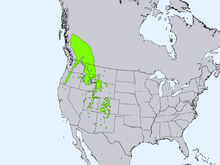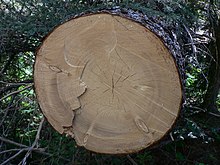Engelmann spruce
| Engelmann spruce | ||||||||||||
|---|---|---|---|---|---|---|---|---|---|---|---|---|

Engelmann spruce ( Picea engelmannii ) |
||||||||||||
| Systematics | ||||||||||||
|
||||||||||||
| Scientific name | ||||||||||||
| Picea engelmannii | ||||||||||||
| Parry ex Engelm. |
The Engelmann spruce ( Picea engelmannii , syn .: Picea glauca subsp. Engelmannii T.MC Taylor 1959) is an evergreen tree from the genus Spruce ( Picea ) in the pine family ( Pinaceae ). It is native to western North America. It was first described by the botanist Charles Christopher Parry in 1863, who named it after the discoverer of the species, the doctor and botanist Georg Engelmann .
description
Habitus
The Engelmann spruce is a fast-growing, evergreen tree that normally reaches heights of 24 to 30 meters and a maximum of 48 meters. The chest height diameter is between 76 and 100 centimeters. The species grows shrubby or dwarf at the tree line. The treetop is very full of wood and narrowly conical. Freestanding trees are branched to the ground. The branches are at an acute angle from the trunk and hang slightly over at the ends. The bark is thin and scaly and flakes off in circular plates 5 to 10 centimeters in diameter. The bark of the young twigs is orange-brown to gray-brown and usually densely hairy. The species is up to 600 years old.
Chromosome number
The number of chromosomes is 2n = 24.
Foliage
The flexible needles are 25 to 32 millimeters long and square in cross-section. They are short-stalked and often pointed, but do not sting. The top of the needle is blue-green with thin stomata lines, the underside blue-white with two broad stomata lines. The needles are often covered with a whitish layer of wax. If you grind the needles they give off a strange smell.
Flowers, cones and seeds
The Engelmann spruce is single-sexed ( monoecious ). She becomes manable at around 25 years of age. The male cones are dark purple in color. The female cones are bright scarlet in color. The egg-shaped, light brown cones when ripe in August to early September of the flowering year hang down and become 2.5 to 6 centimeters long. They are about 1.5 centimeters thick when closed and about 3 centimeters thick when open. They have thin, flexible and wedge-shaped cone scales with a length of 15 to 20 millimeters, the tips of which are often incised. Each cone forms 8 to 20 dark brown to almost black seeds, which are usually released in October. The seeds are 2 to 3 millimeters long, around 2 millimeters wide and have a 12 to 14 millimeter long light brown wing. The thousand grain weight is around 3.3 grams.
root
The Engelmann spruce is a shallow root and therefore at risk of wind throws. Most of the root system is at depths of 30 to 46 centimeters. In deep soils, the root system can penetrate to depths of up to 2.5 meters. The seedlings form a taproot , which soon gives way to the shallow root system. The Engelmann spruce is among other mycorrhizal Partnerships with the Pantherpilz ( Amanita pantheriana ), with C. geophilum , with the milk cap ( Lactarius deliciosus ), with the Blaublättrigen White Täubling ( Russula delica ), with the Cherry Red Spei Täubling ( Russula emetica ) and with Suillus ruber .
Distribution and location
The Engelmann spruce is native to western North America . The distribution area extends from British Columbia and Alberta to northern California and Arizona and New Mexico . It stretches across 9 US states and two Canadian provinces. There are also two isolated populations in northern Mexico . In the Pacific Northwest of the USA, the natural range is east of the coastal mountains. It also includes large parts of the Rocky Mountains . The Engelmann spruce grows at altitudes of 750 to 3,300 meters, rarely deeper in the northwest of the distribution area. In many areas it reaches the tree line . It is planted in gardens and parks around the world because of its attractive appearance.
The Engelmann spruce is a tree species with a cold humid climate . The winters are long, cold and snowy with extreme temperatures as low as –45 ° C. In contrast, the summers are short and cool with maximum temperatures of +32 ° C. Frost can occur at any time of the year. The annual rainfall amount to an average 640 mm. Medium-sized, well-drained, silty or clayey soils are populated that have arisen from basalt, andesite, rhyolite, slate or limestone. The species shows little growth on nutrient-poor, dry, shallow and coarse-grained sands and gravels. It is a species of light tree, but is considered shade-tolerant. The Engelmann spruce forms pure stands and mixed stands with the rocky mountain fir ( Abies lasiocarpa ), the coastal pine ( Pinus contorta ), the white-stemmed pine ( Pinus albicaulis ), with the western Weymouth pine ( Pinus monticola ), with the Douglas fir ( Pseudotsuga menziesii ) and with the American quivering aspen ( Populus tremuloides ).
use
Engelmann spruce is one of the lightest timber in the USA. This spruce wood is used for the production of paper, saw goods and cladding. The slowly grown wood of the Engelmann spruce, which occurs in higher altitudes, is also used for the construction of acoustic guitars , violins and pianos . Engelmann spruces are used as Christmas trees to a lesser extent. Because of its attractive appearance, it is a popular garden and park tree that is grown worldwide. In some countries it is used in snow and wind protection belts. Forest cultivation in Europe was disappointing due to the slow growth and strong knots. Many birds and small mammals feed on seeds and buds of the Engelmann spruce. It offers winter protection to many animals, especially in the far north.
Diseases and pests
The most common fungal disease is wood rot . The main causative agents of root and stick rot are Phellinus nigrolimitatus , Inonotus tomentosus , Flammula alnicola , the brown cellar sponge ( Coniophora puteana ) and species from the genus Hallimasche ( Armillaria ). Stem rot is often caused by the pinewood sponge ( Phellinus pini ), Haematostereum sanguinolentum , Echinodontium sulcatum and the fir layer fungus ( Amylostereum chailletii ). The fungus Chrysomyxa arctostaphyli causes stem deformations , plait drying and loss of growth. The mistletoe species Arceuthobium microcarpum attacks the Engelmann spruce, but occurs only in the southern part of the distribution area. Needle parasites do not pose a serious threat to the species. The bark beetle Dendroctonus rufipennis mainly affects old or overaged populations and is considered to be economically important. Loss of growth and deformations of the trunk are caused by the caterpillars of the moth species Choristoneura freemani , which feed on the plant's needles and buds.
The Engelmann spruce is sensitive to forest fires due to its thin bark.
Systematics
The Engelmann spruce can be divided into two geographical subspecies , although these have been described by some authors as varieties or even as separate species :
- The Engelmann spruce ( Picea engelmannii subsp. Engelmannii ): It occurs from western Canada to the western and west-central United States.
- The Mexican spruce ( Picea engelmannii subsp. Mexicana (Martínez) PA Schmidt ) occurs in two isolated populations in the high mountains of northern Mexico, in the Sierra del Carmen in Coahuila ( Sierra Madre Oriental ) and on the Cerro Mohinora in Chihuahua ( Sierra Madre Occidental ). The Engelmann spruce in the mountains of southwestern New Mexico, southeastern Arizona, and northern Mexico may belong to this subspecies.
The Engelmann spruce crosses extensively in the common distribution area with the closely related white spruce ( Picea glauca ), which is located further north and east in the Rocky Mountains , and more rarely with the closely related Sitka spruce ( Picea sitchensis ) in the western Foothills of the cascade range .
swell
- Schütt, Weisgerber, Schuck, Lang, Stimm, Roloff: Lexicon of Conifers . Nikol, Hamburg 2008, ISBN 3-933203-80-5 , p. 279-286 .
- Entry in The Gymnosperm Database. (engl.)
- Entry with the Flora of North America. (engl.)
Individual evidence
- ↑ IPCN Chromosome Reports: Picea engelmannii Parry ex Engelm. Tropicos.
- ↑ Rafaël Govaerts (ed.): Picea. In: World Checklist of Selected Plant Families (WCSP) - The Board of Trustees of the Royal Botanic Gardens, Kew . Retrieved April 16, 2019.
Web links
- Photos of cones (Engl.)
- Picea engelmannii in the endangered Red List species the IUCN 2006. Posted by: Conifer Specialist Group, 1998. Retrieved on 12 May, 2006.




